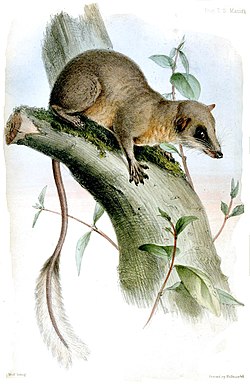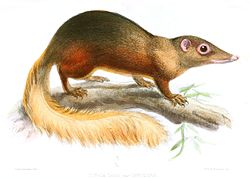| Pen-tailed treeshrew | |
|---|---|
 | |
| Illustration in 1848 species description | |
| Scientific classification | |
| Kingdom: | Animalia |
| Phylum: | Chordata |
| Class: | Mammalia |
| Order: | Scandentia |
| Family: | Ptilocercidae |
| Genus: | Ptilocercus |
| Species: | P. lowii [2] |
| Binomial name | |
| Ptilocercus lowii [2] J. E. Gray, 1848 | |
 | |
| Pen-tailed treeshrew range | |
The pen-tailed treeshrew (Ptilocercus lowii) is a treeshrew of the family Ptilocercidae native to southern Thailand, the Malay Peninsula, Borneo, and some Indonesian islands. [1]
Contents
- Distribution and habitat
- Behaviour and ecology
- Taxonomy and evolutionary history
- References
- External links
It is the only living species in the genus Ptilocercus. All other treeshrew species are grouped in the family Tupaiidae. [2]





